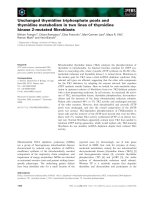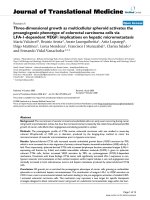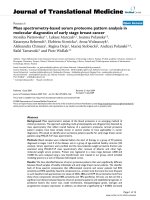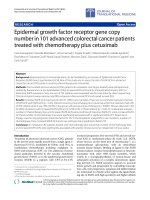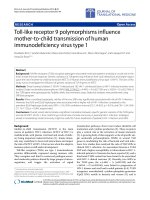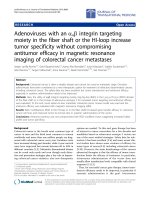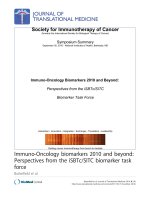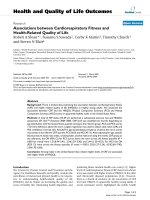báo cáo hóa học:" Maternal plasma viral load and neutralizing/enhancing antibodies in vertical transmission of HIV: A non-randomized prospective study" ppt
Bạn đang xem bản rút gọn của tài liệu. Xem và tải ngay bản đầy đủ của tài liệu tại đây (319.71 KB, 10 trang )
BioMed Central
Page 1 of 10
(page number not for citation purposes)
Virology Journal
Open Access
Research
Maternal plasma viral load and neutralizing/enhancing antibodies in
vertical transmission of HIV: A non-randomized prospective study
Paul Kamara
1
, Loyda Melendez-Guerrero
2
, Miguel Arroyo
3
, Heidi Weiss
4
and
Pauline Jolly*
1
Address:
1
Department of Epidemiology, School of Public Health, University of Alabama at Birmingham, 1665 University Blvd., Ryals Building,
Room 217, Birmingham AL 35294-0022, USA,
2
Department of Microbiology and Medical Zoology, University of Puerto Rico, Medical Sciences
Campus, School of Medicine, San Juan, Puerto Rico,
3
US Military HIV Research Program, Walter Reed Army Institute of Research, Division of
Retrovirology, Silver Spring, MD 20910, USA and
4
Breast Center, Baylor College of Medicine, One Baylor Plaza, MS: BCM 600, 335A, Houston,
TX 77030, USA
Email: Paul Kamara - ; Loyda Melendez-Guerrero - ;
Miguel Arroyo - ; Heidi Weiss - ; Pauline Jolly* -
* Corresponding author
HIV vertical transmissionHIV neutralizationmaternal viral loadHIV enhancement
Abstract
Background: We examined the association and interaction between maternal viral load and antibodies
in vertical transmission of HIV in a non-randomized prospective study of 43 HIV-1 infected pregnant
women who attended the San Juan City Hospital, Puerto Rico, and their 45 newborn infants. The women
and infants received antiretroviral therapy.
Methods: A nested PCR assay of the HIV-1 envelope V3 region and infant PBMC culture were performed
to determine HIV status of the infants. Maternal and infant plasma were tested for HIV neutralization or
enhancement in monocyte-derived macrophages.
Results: Twelve (26.7%) infants were positive by the HIV V3 PCR assay and 3 of the 12 were also positive
by culture. There was a trend of agreement between high maternal viral load and HIV transmission by
multivariate analysis (OR = 2.5, CI = 0.92, p = 0.0681). Both maternal and infant plasma significantly (p =
0.001 for both) reduced HIV replication at 10
-1
dilution compared with HIV negative plasma. Infant plasma
neutralized HIV (p = 0.001) at 10
-2
dilution but maternal plasma lost neutralizing effect at this dilution. At
10
-3
dilution both maternal and infant plasma increased virus replication above that obtained with HIV
negative plasma but only the increase by maternal plasma was statistically significant (p = 0.005). There
were good agreements in enhancing activity in plasma between mother-infant pairs, but there was no
significant association between HIV enhancement by maternal plasma and vertical transmission.
Conclusion: Although not statistically significant, the trend of association between maternal viral load and
maternal-infant transmission of HIV supports the finding that viral load is a predictor of maternal-infant
transmission. Both maternal and infant plasma neutralized HIV at low dilution and enhanced virus
replication at high dilution. The antiretroviral treatments that the women received and the small sample
size may have contributed to the lack of association between HIV enhancement by maternal plasma and
vertical transmission.
Published: 24 February 2005
Virology Journal 2005, 2:15 doi:10.1186/1743-422X-2-15
Received: 05 October 2004
Accepted: 24 February 2005
This article is available from: />© 2005 Kamara et al; licensee BioMed Central Ltd.
This is an Open Access article distributed under the terms of the Creative Commons Attribution License ( />),
which permits unrestricted use, distribution, and reproduction in any medium, provided the original work is properly cited.
Virology Journal 2005, 2:15 />Page 2 of 10
(page number not for citation purposes)
Background
The rate of HIV-1 infection has been increasing rapidly
among women of childbearing age. At the end of 2003
women accounted for 50% of adults living with HIV/AIDS
worldwide [1]. Consequently, the number of pediatric
AIDS cases due primarily to perinatal (peripartum or
intrapartum) transmission is rapidly increasing. Mother-
to-child transmission accounts for more than 90% of all
HIV infections in infants and children worldwide. In 2003
an estimated 2.1 million children under 15 years were liv-
ing with HIV/AIDS [1]. Zidovudine (ZDV) given as either
an intensive or short course regimen significantly reduces
perinatal transmission [2,3]. However, because of its cost,
ZDV is not always available in poorer countries of the
world. Successful use of nevirapine therapy in preventing
perinatal transmission offers hope for more affordable
treatment for poor women worldwide [4,5]. However, in
2003, only one in ten pregnant women was offered serv-
ices for preventing mother-to-child HIV transmission [1].
Further, whether treated with ZDV or nevirapine, a por-
tion of HIV-positive women still transmit virus to their
offspring vertically and the problem of maternal-infant
transmission through breast milk remains unsolved.
Therefore, there is need for continued studies of viral and
immunological factors associated with maternal-infant
transmission of HIV so that other effective and affordable
strategies to prevent transmission may be developed.
Although some studies show no association between the
presence of HIV neutralizing antibodies in maternal sera
and the risk of perinatal transmission [6,7], other studies
report a reduction in the risk of vertical transmission in
pregnant women whose sera contain neutralizing anti-
bodies to HIV [8]. A number of studies have indicated
lower transmission rates from infected pregnant women
with high antibody titer or with high affinity/avidity anti-
body to conserved portion of HIV-1 glycoprotein 41 [9],
to the CD4 binding site [10] or the V3 loop of glycopro-
tein 120 [11,12], and to the p24 Gag protein [13]. Other
studies have reported that non-transmitting mothers
more frequently have such antibodies to their own virus
than do transmitting mothers and that transmitting moth-
ers rarely have neutralizing antibody against their own
children's isolates [14,15]. In contrast, a study by St.
Louis, et al. [16] found no evidence that anti-V3 loop anti-
body protected against perinatal transmission. Further, a
study by Lallemant, et al. [17] showed that mothers with
higher antibody titers to peptides corresponding to the V3
region of gp120 and the immunodominant domain of
gp41 had a higher risk of perinatal transmission. The
authors hypothesized that women who display the broad-
est antibody response to V3 may be experiencing the
greatest viral turnover [18] which could make them more
at risk for transmitting virus to their offspring.
In contrast to neutralizing antibodies, non-neutralizing
antibodies may enhance HIV infection by binding to the
virus and facilitating its uptake by cell types that carry
immunoglobulin (Fc) or complement receptors. Antibod-
ies that enhance HIV replication in vitro by either Fc
gamma receptor- or complement receptor-mediated
endocytosis (FcγR-ADE or C'-ADE) have been identified
in sera from HIV-1-infected individuals [19-25] and from
many gp120-vaccinated volunteers [19,20]. An in vitro
study of antibody dependent enhancement (ADE) of HIV-
1 infection in human term syncytiotrophoblast cell cul-
tures suggested that both FcγR-ADE and C'-ADE may con-
tribute to maternal-infant transmission of HIV-1 [26].
Pancino, et al. [27], reported that mother-infant transmis-
sion of HIV was associated with maternal antibodies to
the envelope gp160 and to a highly conserved domain of
the trans-membrane glycoprotein. Mann, et al. [28],
observed that certain combinations of antibody sub-
classes occurred more frequently in mothers who trans-
mitted HIV-1 to their offspring than in non-transmitters
and suggested that ADE may occur in mother-infant trans-
mission of HIV-1. However, C'-ADE was not found to be
associated with maternal-infant transmission of HIV [29]
and the role of FcγR-ADE in maternal-infant transmission
has not been determined.
Maternal plasma virus load has been shown to be strongly
associated with perinatal transmission of HIV [27,30,31]
and it was reported that there is no absolute threshold of
maternal viral load below which HIV transmission does
not occur [32]. Although transmission did not occur at a
threshold below 2,000 copies/ml [18,33] or below 1000
copies/ml [34], more recent meta-analysis has demon-
strated that occasional transmission does occur below a
viral load threshold of 1,000 copies/ml [35]. Another
study indicated that viral load correlated with vertical
transmission in women at the clinical stage A1 (asympto-
matic) of infection [36].
However, the association of both viral load and enhanc-
ing activity (presumably by FcγR-ADE) in maternal
plasma and vertical transmission of HIV has not formerly
been examined. Thus, we examined the association of
these factors (independently and combined) in vertical
transmission using samples from mother-infant pairs
from San Juan, Puerto Rico, previously described by
Melendez-Guerrero et al [37]. Neutralization/enhance-
ment of a R5 tropic strain of HIV-1 subtype B by maternal
plasma was examined in monocyte-derived macrophage
cultures.
Results and Discussion
Study sample
A cohort of 43 HIV-1 subtype B infected pregnant women
attending antenatal clinic at the San Juan City Hospital,
Virology Journal 2005, 2:15 />Page 3 of 10
(page number not for citation purposes)
Puerto Rico, was enrolled into a prospective study from
their first antenatal visit until delivery [37]. Eleven women
were enrolled during their first trimester, 24 during their
second trimester, and 8 during their third trimester of
pregnancy. Approximately forty-five HIV-1 infected
women gave birth at the San Juan City hospital during
1998. All of the women recruited into the study received
some form of antiretroviral therapy as detailed and refer-
enced [3,38-44] in Table 1. All of the infants were enrolled
into the study shortly after delivery and most (86%) were
also enrolled in the antiviral protocols during their first six
weeks of life (Table 1). One mother had triplets, therefore,
a total of 43 mothers and 45 infants (regarded as 45
mother-infant pairs) were enrolled.
Demographic and clinical characteristics of the mothers
and vertical transmission
The mean age of the mothers was 24 years (range 14–38
years; Table 2). Majority of the women (88.4%) were
infected through heterosexual contact. Based on the 1993
CDC revised classification system for HIV infection and
disease progression, only 6 of the mothers (those in the
A3 and B3 categories) were classified as AIDS cases [45].
Approximately two-thirds (67.4%) of the mothers had
viral load levels below 10,000 RNA copies/ml and were
classified as having low viral loads (LVL) based on the cat-
egorization by Contopoulos-Ioannidis & Ioannidis [46].
The remaining 32.6% of mothers had viral loads above
10,000 RNA copies/ml and were classified as having high
viral loads (HVL). CD4+ T cell counts in the women
ranged from 23 to 1165 cells/mm
3
of blood with a mean
count of 425 cells/mm
3
. Twenty-six of the 43 women
delivered their babies by normal vaginal delivery; the
remaining women had cesarean sections (Table 2).
Twelve (26.7%) of 45 infants were HIV V3 positive indi-
cating that HIV transmission had occurred (Table 2).
However, only three of these twelve infants were also HIV
culture positive. This infection rate of approximately 7.0%
observed is similar to the rate of 8.3% observed for ZDV
Table 1: Number and percent of HIV positive pregnant women and infants assigned to the different AIDS Clinical Trails Group
(ACTG) protocols or to zidovudine (ZDV)
ACTG Protocol # Number of women (%) Dose and frequency
185 [38] 16 (37.2) Mother: ZDV according to 076 protocol [3] plus anti-HIV immune serum globulin
(HIVIg) or immune globulin (Ig) (200 mg/kg) every 28 days followed by 1.0 mg/kg/hr
continuous infusion during labor and delivery.
Infant: HIVIg (200 mg/kg) or normal Ig within 12 hrs of birth plus oral ZDV syrup (2.0
mg/kg) every 6 hours after birth (beginning within 8–12 h) and continuing for 6 weeks.
249 [39] 4 (9.3) Mother: Didanosine (ddi) IV (1.6 mg/kg) on day one, during pregnancy, followed by an
oral dose (200 mg) one week after the initial dose. Oral ddi is then administered every
12 hrs until labor starts and every 12 hrs after delivery until 6 weeks post-partum.
During labor and delivery patients receive a loading dose followed by continuous
infusion.
Infant: Oral ZDV syrup (2.0 mg/kg) every 6 hours after birth and continuing to week
6.
250 [40] 5 (11.6) Mother: ZDV plus Nevirapine (200 mg/kg) single dose during labor.
Infant: Oral ZDV syrup (2.0 mg/kg) every 6 hours after birth and continuing to week
6 plus single dose of Nevirapine (2 mg/kg) after birth.
296 [41] 3 (7.0) Mother: ZDV as in protocol 185.
Infant: Oral ZDV syrup (2.0 mg/kg) every 6 hours after birth and continuing to week
6.
316 [42] 9 (20.9) Mother: Nevirapine (200 mg oral dose) or the corresponding placebo during delivery
plus ZDV (as in 076).
Infant: ZDV perinatal prophylaxis (2.0 mg/kg) plus single 2.0 mg/kg oral dose of
Nevirapine or Nevirapine placebo administered between 48 and 72 hrs of life.
324 [43] 3 (7.0) Mother: ZDV before and after delivery as is usual but oral administration of ZDV
(300 mg) every 3 hrs, 3 doses total during delivery.
Infant: Oral ZDV syrup (2.0 mg/kg) every 6 hours after birth and continuing to week
6.
332 [44] 1 (2.3) Mother: Stravudine (d4T, 30–40 mg) during pregnancy and 0.05 mg/kg/hr during
delivery in combination with 3TC 150 mg followed by 150 mg during delivery.
Infant: Stravudine (d4T, 1 mg/kg) single dose on day 35–42, in combination with 3TC
(2.0 mg/kg/dose).
ZDV [3] 2 (4.7) Mother: ZDV (2.0 mg/kg) every 28 days followed by 1.0 mg/kg/hr continuous infusion
during labor.
Infant: Oral ZDV syrup (2.0 mg/kg) every 6 hours after birth and continuing to week
6.
Virology Journal 2005, 2:15 />Page 4 of 10
(page number not for citation purposes)
treated mothers and infants in the 076 study [4]. Based on
the V3 PCR results an equal number of mothers with low
and high viral load (6 in each group) transmitted HIV to
their infants. The mean log viral load of transmitting
mothers 3.77 + 0.31 (median = 3.77) was higher than of
the non-transmitting mothers 3.54 + 0.15 (median =
3.44) but the difference was not statistically significant (p
= 0.474). This is probably due to the small sample size.
The mothers of the three infants who were HIV culture
positive all had high viral load levels (484,703, 11,642
and 10,220 RNA copies/ml) but the levels in two of the
three were close to the 10,000 RNA copies/ml cut-off
value used to distinguish LVL from HVL. Since perinatal
transmission occurs mostly at or during delivery, the viral
load in the genital tract (which may be similar to maternal
plasma level) [47] may be an important determinant in
maternal-infant transmission.
The mothers of HIV V3 positive infants had a non-signifi-
cantly higher mean CD4+ T count (526 cells/mm
3
,
median = 508 cells/mm
3
) compared to non-transmitting
mothers (mean CD4+ T count of 413 cells/mm
3
; median
= 336 cells/mm
3
). Maternal CD4 cell counts have been
shown to be a less effective predictor of transmission of
HIV than viral load [18]. Further, most of the women in
the study (86%) had CD4+T cell counts above the 200
cells/mm
3
level which is used to define AIDS. Only one of
the three women whose infants were HIV culture positive
had AIDS (CD4 = 149 cells/mm
3
). The other two women
had CD4 counts of 510 and 538 cells/mm
3
.
Table 2: Age, source of infection, clinical status and transmission
outcome for HIV-positive mothers
Variable Number (%)
Age of mothers (years)
a
< 25 14 (32.6)
25–30 12 (27.9)
> 30 16 (37.2)
Missing 1 (2.3)
Source of infection
Heterosexual contact 38 (88.4)
IV drug use 3 (7.0)
Unknown 2 (4.6)
Clinical status (CDC classification 45)
A1 11 (25.6)
A2 14 (32.6)
A3 1 (2.3)
B1 2 (4.6)
B2 10 (23.3)
B3 5 (11.6)
Viral load (copies/ml)
b
<10,000 (range 83–9,078) 29 (67.4)
≥ 10,000 (range 10,220–484,703) 14 (32.6)
Mode of delivery
Vaginal 26 (60.5)
Cesarean 17 (39.5)
Transmission outcome
V3 PCR+ Infants 12 (26.7)
V3 PCR- Infants 33 (73.3)
Culture+ Infants 3
c
(6.7)
Culture- Infants 42 (93.3)
a
Mean age 24 years (range 14–28 years)
b
Mean viral load 28,112 copies/ml (range = 83 – 484,703 copies/ml)
c
HIV infection confirmed by PCR and culture
Table 3: Neutralization/enhancement of HIV infection by plasma from 12 transmitter and 33 non-transmitter mothers and 12 HIV V3
positive and 33 HIV V3 negative infants
Plasma Dilution and effect Transmitter mothers
Number (%)
Non-transmitter mothers
Number (%)
HIV V3+ infants Number
(%)
HIV V3- infants Number
(%)
10-1
Neutralized 11 (92) 31 (94) 11 (92) 30 (91)
Enhanced 0 (0) 0 (0) 0 (0) 0 (0)
No change 1 (8) 2 (6) 1 (8) 3 (9)
10-2
Neutralized 9 (75) 25 (76) 7 (58) 23 (70)
Enhanced 1 (8) 2 (6) 2 (17) 1 (3)
No change 2 (17) 6 (18) 3 (25) 9 (27)
10-3
Neutralized 8 (67) 19 (58) 4 (33) 9 (27)
Enhanced 0 (0) 5 (15) 4 (33) 7 (21)
No change 4 (33) 9 (27) 4 (33) 17 (52)
Virology Journal 2005, 2:15 />Page 5 of 10
(page number not for citation purposes)
Neutralization/enhancement of HIV treated with maternal
and infant plasma
The effect of plasma (at 10
-1
to 10
-3
dilutions) from the
mothers (transmitters and non-transmitters) and infants
(HIV V3+ and HIV V3-) on HIV replication was examined
in the neutralization/enhancement assay (Table 3). HIV
p24 antigen in culture fluids was determined using the
coulter p24 antigen assay kit (Coulter, Miami FL) accord-
ing to the manufacturer's instructions. The mean value of
HIV p24 antigen by dilution was calculated from seroneg-
ative samples. The percent change (increase or decrease)
in p24 antigen of the maternal or infant plasma from the
mean of the seronegative samples was calculated. Neutral-
ization was defined as 70% or greater reduction in HIV
p24 antigen in cultures treated with HIV positive plasma
compared with cultures treated with HIV negative plasma.
Enhancement was defined as 100% or greater increase in
p24 antigen in cultures treated with HIV positive plasma
compared to the p24 level in cultures treated with HIV
negative plasma. Traditionally enhancement of HIV in
PBMC cultures has been defined as a 1.5 to 2.5-fold or
greater increase in virus replication as a result of treatment
with immune sera [21,25,48]. Table 3 shows that at 10
-1
dilution, over 90% of plasma samples from both groups
of mothers (transmitters/non-transmitters) and infants
(HIV V3+/ HIV V3-) neutralized HIV. At 10
-2
dilution the
percentages of plasma that neutralized HIV dropped to
approximately 75% for both groups of mothers and to
58% and 70% for HIV V3+ and HIV V3- infants respec-
tively. The percentages again dropped at 10
-3
dilution to ≤
67% for mothers and ≤ 33% for infants (Table 3). Chi-
square or Fisher's exact test were used to compare the pro-
portion of plasma from transmitter versus non-transmit-
ter mothers and between HIV V3+ and HIV V3- infants
that neutralized, enhanced or resulted in no change in
HIV replication. No significant differences were found.
The mean percent change in p24 antigen and standard
errors for mothers and infants were plotted for each group
by plasma dilution (Figure 1). The Wilcoxon signed-
ranked test was used to determine whether the percent
change was significantly different from zero. Both the
maternal and infant plasma significantly (p = 0.001 for
both groups) reduced HIV replication at low (10
-1
) dilu-
tion when compared with HIV negative sera (Figure 1). At
10
-2
dilution the infant plasma still significantly (p =
0.001) reduced virus replication, but the maternal plasma
lost neutralizing activity (Figure 1). At 10
-3
dilution, the
maternal plasma significantly increased virus replication
(p = 0.005) above seronegative plasma and the infant
plasma showed a non-significant increase (88%) in HIV
replication (Figure 1). These findings of neutralization by
plasma of HIV positive individuals at low dilutions and
enhancement at higher dilutions are similar to data
published by Jolly and Weiss [49], which showed that
neutralizing and enhancing antibodies can occur simulta-
neously in sera of HIV-infected individuals. If neutralizing
antibody is present, enhancement is seen only at high
dilutions, whereas, if only enhancing antibody is present,
enhancement is observed without, or at low, plasma/
serum dilutions.
Enhancing activity in plasma from mothers and infants
Sixty-nine percent (31/45) of plasma from mother-infant
pairs were also tested in the neutralization/enhancement
assay at higher dilutions (10
-4
to 10
-6
). Examination of
enhancing activity in plasma of mothers and infants
showed that there were good agreements (60% or greater)
in enhancement status between mother-infant pairs. For
example, at 10
-4
dilution, the plasma of 7 infants of 9
mothers (78%) whose plasma enhanced HIV replication
also exhibited enhancement, and at 10
-6
dilution, the
plasma of 8 infants of 10 mothers (80%) whose plasma
enhanced HIV replication also exhibited enhancement
(data not shown). Comparison of p24 antigen between
transmitter and non-transmitter mothers or their infants
at 10
-4
to 10
-6
dilutions showed no significant difference
between the two groups of mothers or infants. The lack of
association of enhancing activity and HIV transmission in
this study is similar to the findings for C'-ADE by Gras, et
al. [29]. We examined complement-independent (pre-
sumably FcγR-mediated antibody dependent) enhance-
ment in primary human macrophages because we
thought that this type of enhancement would be more rel-
evant to HIV clinical disease and transmission. FcγR-medi-
ated enhancement is characteristic of diseases such as
dengue and feline infectious peritonitis for which ADE
has been best demonstrated to occur [50,51]. In addition,
macrophages are important target cells for infection and
replication in vivo by most HIV-1 variants [52-54]. How-
ever, our results showed no association between enhanc-
ing activity in maternal or infant plasma and maternal-
infant transmission of HIV. The negative results could in
part be due to the various anti-retroviral protocols to
which the women were assigned.
Correlation between maternal and infant p24 antigen
levels and maternal viral load with maternal and infant
p24 antigen
Using Spearman's correlation, we examined the associa-
tion between maternal viral load and enhancing activity
in vertical transmission of HIV by using mothers' charac-
teristics (viral load and p24 antigen value) and the infants'
p24 antigen values. A correlation matrix showed a posi-
tive association between mothers' p24 antigen values and
those of their infants (Table 4). However, low positive or
no associations were found between maternal viral load
and maternal p24 antigen values at low dilutions (10
-1
–
10
-3
) and low negative associations at higher dilutions
(10
-4
– 10
-6
). There were low positive associations
Virology Journal 2005, 2:15 />Page 6 of 10
(page number not for citation purposes)
between maternal viral load and the p24 antigen values of
their infants at low dilutions (10
-1
– 10
-3
) and low nega-
tive correlations at higher dilutions except at 10
-5
dilution
(Table 4). However, none of the values was statistically
significant.
Maternal viral load and enhancing antibodies as predictors
of vertical transmission of HIV
Univariate analysis of type of treatment, stage of HIV dis-
ease, method of delivery and CD4+ T cell count of the
mothers indicated no significant association with vertical
transmission of HIV (p > 0.05). The combined effect of
maternal viral load and enhancing antibodies as potential
Neutralization/enhancement of HIV-1BaL by maternal and infant plasma diluted 10
-1
– 10
-3
Figure 1
Neutralization/enhancement of HIV-1BaL by maternal and infant plasma diluted 10
-1
– 10
-3
. Virus replication (determined by
p24 antigen (pg/ml) in culture fluids collected 2–4 days post-infection) is compared to replication of virus treated with plasma
from HIV-1 seronegative (sn) women. The data represent the average of all maternal and infant samples. Two independent
infections were conducted with each sample in duplicate (4 replicates) for each of 43 maternal and 45 infant plasma. Maternal
and infant plasma significantly reduced HIV replication (p = 0.001 for both) at 10
-1
dilution compared to HIV negative sera.
Infant plasma also significantly reduced HIV replication (p = 0.001) at 10
-2
dilution. At 10
-3
dilution maternal plasma significantly
increased HIV replication (p = 0.005) above HIV negative sera and infant plasma showed a non-significant increase (88%) in HIV
replication.
-50
0
50
100
150
200
250
300
Plasma Dilution
Percent Compared to Seronegative p24
antigen
sn
mother
infant
10
-1
10
-2
10
-3
Virology Journal 2005, 2:15 />Page 7 of 10
(page number not for citation purposes)
risk factors for the vertical transmission of HIV-1 was
examined in a multivariable model. Log viral load was
treated as a continuous variable in the model and
enhancement was categorized as enhancement versus
neutralization. There was a trend of association between
maternal viral load and transmission of HIV-1 so that the
higher the viral load, the more likely mothers were to
transmit HIV-1 to their infants (OR= 2.5, CI= 0.93 – 6.67,
p = 0.0681). This is in agreement with other studies dis-
cussed earlier that show viral load as a predictor of mater-
nal-infant transmission [27,30,31]. The non-significant
result in this study is probably due to the small sample
size. Also, twice as many mothers (29) in this study had
low plasma HIV RNA levels (<10,000 RNA copies/ml)
compared to those with high viral load levels (14 moth-
ers). The preponderance of women with low viral load
levels may be the result of the effect of the different
antiretroviral protocols that the women were given during
pregnancy. Whereas Dickover, et al. [30] showed that
women given zidovudine during gestation showed an
eight-fold median decrease in plasma HIV RNA levels (p <
0.001), Sperling, et al., [32] have shown that ZDV treat-
ment had only a minimal effect in decreasing maternal
HIV RNA levels. In this study all of the women except one
(given stravudine) received ZDV treatment and in most
cases ZDV was given along with one other anti-retroviral
drug or with HIVIg (Table 1). There was no significant
association between enhancing activity (based on p24
antigen values) in the plasma of mothers who transmitted
HIV-1 to their infants based on the HIV V3+ status of the
infants (OR = 0.92, CI = 0.41 – 2.07, p = 0.8492).
Conclusion
In agreement with published data, multivariate analysis
showed a trend of association between maternal viral load
and maternal-infant transmission of HIV. The non-signif-
icant difference in the mean log viral load of transmitting
and non-transmitting mothers is probably due to the
small sample size. No significant associations were found
between HIV antiretroviral treatment protocols, classifica-
tion of HIV disease, method of infant delivery and CD4+
T cell count of the mothers and vertical transmission of
HIV. Both maternal and infant plasma significantly neu-
tralized HIV infection at low (10
-1
) dilution and enhanced
virus replication at higher dilution (10
-3
). Neutralizing
and enhancing antibodies can occur together in the blood
of HIV positive individuals and the neutralizing effect can
be lost at high plasma dilution.
There were good agreements in the neutralizing or
enhancing activity of the plasma from mothers-infant
pairs. That is, when plasma of the mothers neutralized or
enhanced HIV infection, their infants' plasma showed
similar activity. However, there was no significant associ-
ation between virus enhancement by maternal plasma
and vertical transmission of HIV. Thus, enhancing activity
in plasma of these HIV-infected mothers was not a domi-
nant factor in vertical transmission of HIV.
Methods
Collection, processing and testing of maternal and infant
blood samples for HIV
Blood samples were taken from the mothers during each
trimester of pregnancy and during delivery. Blood sam-
ples from the infants were collected from the umbilical
cord at birth and at 1–2, 3–4 and 5–12 months. Blood was
collected in vacutainer tubes containing ACD anticoagu-
lant and centrifuged at 2500 rpm for 15 minutes. The
plasma was stored frozen (-20°C) for use in maternal viral
load and HIV neutralization/enhancement assays. The
remaining blood was diluted in phosphate-buffered
saline (PBS) pH 7.4 and processed by Ficoll-hypaque den-
sity gradient for cell isolation. For virus isolation, one mil-
lion cells from each mother or infant were co-cultured
Table 4: Correlation (Spearman) of maternal and infant p24 antigen levels and maternal viral load with maternal and infant p24
antigen
Plasma dilution p24 antigen (M vs I) Correlation
a
log
(p-value)
b
MVL and Mp24 Correlation
c
log
(p-value)
b
MVL and Ip24 Correlation
d
log
(p-value)
b
10
-1
0.412 (0.005) 0.12 (0.448) 0.09 (0.562)
10
-2
0.59 (0.0001) 0.18 (0.249) 0.11 (0.473)
10
-3
0.72 (0.0001) 0.14 (0.355) 0.04 (0.832)
10
-4
0.40 (0.028) -0.15 (0.423) -0.16 (0.394)
10
-5
0.75 (0.0001) -0.10 (0.581) 0.31 (0.091)
10
-6
0.69 (0.0001) -0.34 (0.064) -0.31 (0.089)
M = mother; I = infant; MVL = maternal viral load; Mp24 = maternal p24 antigen; Ip24 = infant p24 antigen
a
Spearman correlation coefficient between log values of maternal and infant p24 antigen.
b
p-value to test for statistically significant correlation.
c
Spearman correlation coefficient between log values of maternal viral load and maternal p24 antigen.
d
Spearman correlation coefficient between log values of maternal viral load and infant p24 antigen.
Virology Journal 2005, 2:15 />Page 8 of 10
(page number not for citation purposes)
with HIV seronegative donor cells previously stimulated
by PHA as described in the ACTG virology manual [55].
The remaining cells (10
5
) were stored frozen at -85°C. The
HIV status of the infants was determined using a nested
PCR assay of the HIV-1 envelope variable (V3) region as
previously described [37,56]. This V3 PCR assay was con-
ducted in duplicates and repeated on the infant samples at
1–2 months, 3–4 months and 5–11 months. Culture for
HIV was repeated on infant samples collected at 3, 6 and
12 months and all except 3 infants were culture negative.
Determination of maternal viral load
HIV RNA copies in maternal plasma was determined by
the amplicor HIV monitor test (Roche Diagnostics,
Branchwater, NJ, USA) at the Puerto Rico ACTG-certified
laboratory [37]. A 142 base-pair sequence in the HIV gag
gene was amplified by RT-PCR for viral load determina-
tion. The mean log viral load was calculated and com-
pared between transmitting and non-transmitting
mothers to determine the effect of maternal viral load on
HIV vertical transmission.
Preparation and titration of HIV-1BaL for the
neutralization/enhancement assay
HIV-1BaL stock was prepared in primary macrophages as
reported previously by Jolly [57]. Briefly, HIV-1BaL super-
natant fluid (1 × 10
4.6
TCID
50
/ml) obtained from the NIH
AIDS Research and Reference Reagent Program was used
to inoculate fresh cultures of macrophages grown on 75
ml tissue culture flasks. The cultures were washed 24
hours later and incubated with fresh media. Supernatant
fluids were harvested at 7 and 14 days post-infection, clar-
ified by centrifugation at 1800 rpm for 10 minutes and
used as stock virus for these studies. The stock contained
5 × 10
5
TCID
50
/ml.
Neutralization/enhancement assay
A neutralization/enhancement assay was conducted using
maternal or infant samples and HIV-1BaL. Maternal
plasma samples collected during the third trimester of
pregnancy were used in these assays since most prenatal
HIV infections occur in the third trimester [58]. Briefly,
10-fold dilutions of heat inactivated (56°C for 30 min)
plasma samples were mixed 1:1 with 10
3
TCID
50
/ml of
virus and pre-incubated at 37°C for 30 min. The mixtures
were then inoculated into replicate cultures of monocyte-
derived macrophages as prepared previously [57] in 8 well
chamber slides and incubated at 37°C for 6 hours in a 5%
CO
2
incubator. The inocula were removed and the cells
washed, and incubated with fresh media for up to 8 days.
Culture supernatant fluids were then collected on days 2,
4, 6, and 8 and tested for p24 antigen using the Coulter
assay (Coulter, Miami, FL, USA). Cultures treated with
HIV-negative sera were used as controls. All maternal and
infant plasma samples were tested at three 10-fold dilu-
tions; 69% of samples were tested up through six 10-fold
dilutions. Two independent assays were conducted for
each maternal or infant plasma sample and each sample
was run in duplicate on each assay (4 replicates).
Statistical analysis
Descriptive statistics such as mean, median, range were
calculated to summarize maternal characteristics such as
viral load, CD4+ T cell count and p24 antigen levels. The
number of HIV vertical transmission among infants was
summarized and the univariate association of maternal
characteristics, such as, treatment (type of antiretroviral
therapy), stage of disease based on the 1993 CDC classifi-
cation [45], method of delivery (C-section vs. vaginal),
and CD4+ T cell count, with HIV transmission in infants
was evaluated using the Fisher's exact test. The simultane-
ous effect of maternal viral load and p24 levels on infant
transmission was evaluated using the logistic regression
model. Odds ratio and 95% confidence intervals were cal-
culated for the effect of both factors in the model.
Correlation between maternal versus infant p24 antigen
levels and between maternal viral load and maternal or
infant p24 antigen levels was evaluated using the Spear-
man's correlation coefficient. Enhancement, decrease
(neutralization), or no change in p24 levels compared to
seronegative control was assessed for mother-infant pairs.
The distribution of virus p24 antigen was compared
between transmitting vs. non-transmitting mothers and
between HIV V3+ infants and HIV V3- infants using
Fisher's exact test.
Competing interests
The author(s) declare that they have no competing
interests.
Authors' contributions
LMG and PEJ were involved in conception and design of
the study, collection of the samples, interpretation of the
data and drafting and critical review of the manuscript. PK
and MA were involved in performing the laboratory
experiments that resulted in the acquisition of the data, in
data entry, and in drafting and revising the manuscript
with LMG and PEJ. HLW was responsible for data analysis
and interpretation along with PEJ, LMG and PK. All
authors have read and approved the final manuscript.
Acknowledgements
This study was supported by the CFAR-RCMI supplement grant P30-AI-
2767 from the NIAID/NIH, the "Research Centers in Minority Institutions"
award G12RR-03051 from the National Center for Research Resources,
NIH, award 3 S06 GM08224 from the National Institutes of General Med-
ical Sciences, NIH, and awards RO1 AI 39194 and 5P30 AI27767 from the
NIAID/NIH. We appreciate the contribution of the nurses who followed
the mothers and infants in the study and the pediatrician in charge of the
ACTG clinic. We thank Gill Nieves for help in developing viral macrocul-
Virology Journal 2005, 2:15 />Page 9 of 10
(page number not for citation purposes)
tures and M. Vega and G. Hillyer for help with phenotypic and viral load
analyses, respectively. HIV-1BaL from Dr. Suzanne Gartner and Dr. Mikulas
Popovic was obtained through the AIDS Research and Reference Reagent
Program, Division of AIDS, NIAID, NIH.
References
1. UNAIDS: Report on the global HIV/AIDS epidemic: Joint United Nations
Programme on HIV/AIDS 2004.
2. Centers for Disease Control and Prevention (CDC): Administra-
tion of zidovudine during late pregnancy and delivery to pre-
vent peri-natal HIV transmission – Thailand, 1996–1998.
Morb Mortal Wkly Rep 1998, 47:151-4.
3. Connor EM, Sperling RS, Gelber R, Kiselev P, Scott G, Sullivan MJ, Van
Dyke R, Bey M, Shearer W, Jacobson R, Jimenez E, O'Neill E, Bazin B,
Delfraissy JF, Culnane M, Coombs R, Elkins M, Moye J, Stratton P,
Balsley J: Reduction of maternal-infant transmission of human
immunodeficiency virus type 1 with zidovudine treatment.
New Eng J Med 1994, 331:1173-1180.
4. Guay L, Musoke P, Fleming T, Bagenda D, Allen M, Nakabiito C, Sher-
man J, Bakaki P, Ducar C, Deseyve M, Emel L, Mirochnick M, Fowler
MG, Mofenson L, Miotti P, Dransfield K, Bray D, Mmiro F, Jackson JB:
Intrapartum and neonatal single-dose nevirapine compared
with zidovudine for prevention of mother-to-child transmis-
sion of HIV-1 in Kampala, Uganda: HIVNET 012 Randomised
Trial. Lancet 1999, 354:795-802.
5. US Department of Health and Human Services: Researchers iden-
tify a simple, affordable drug regimen that is highly effective
in preventing HIV infection in infants of mothers with the
disease. HHS News . July 14, 1999
6. Hengel RL, Kennedy MS, Steketee RW, Thea DM, Abrams EJ, Lam-
bert G, McDougal JS, the New York City Perinatal HIV Transmission
Collaborative Study Group: Neutralizing antibody and perinatal
transmission of human immunodeficiency virus type 1. AIDS
Res Human Retrovir 1998, 14:475-481.
7. Mabondzo A, Rouvier P, Raoul H, Le Naour R, Courpotin C, Herve
F, Parnet-Mathieu F, Lasfargues G, Dormont D: Relationship
between humoral factors in HIV-1-infected mothers and the
occurrence of HIV infection in their infants. Clin Exp Immunol
1995, 102:476-480.
8. Scarlatti G, Albert G, Rossi P, Hodara V, Biraghi P, Muggiasca L, Fenyo
EM: Mother-to-child transmission of human immunodefi-
ciency virus type 1: Correlation with neutralizing antibodies
against primary isolates. J Infect Dis 1993, 168:207-10.
9. Ugen KE, Goedert JJ, Boyer J, Rafaeli Y, Frank I, Williams WV,
Willoughby A, Landesman S, Mandez H, Rubinstein A, Kieber-
Emmons T, Weiner DB: Vertical transmission of human immu-
nodeficiency virus (HIV) infection. Reactivity of maternal
sera glycoprotein 120 and 41 peptides from HIV Type 1. J Clin
Invest 1992, 89:923-1930.
10. Khouri YF, MacIntosh K, Cavacini L, Posner M, Pagano M, Tuomala R,
Marasco WA: Vertical transmission of HIV-1. correlation with
maternal viral load and plasma levels of CD4 binding site
anti-gp 120 antobodies. J Clin Invest 1995, 95:732-737.
11. Devash Y, Calvelli TA, Wood DG, Reagan KJ, Rubinstein A: Vertical
transmission of human Immunodeficiency virus is correlated
with the absence of high-affinity/avidity maternal antibodies
to the gp120 principal neutralizing domain. Proc Natl Acad Sci
1990, 87:3445-3449.
12. Rossi P, Moschese V, Broliden PA, Fundaro C, Plebani A, Giaquinto
C, Tovo PA, Ljunggren K, Rosen J, Wigzell H, Jonda M, Wharen B:
Presence of maternal antibodies to human immunodefi-
ciency virus 1 envelope glycoprotein gp120 epitopes corre-
lates with the uninfected status of children born to
seropositive mothers. Proc Natl Acad Sci USA 1989, 86:8055-8.
13. Erb P, Krauchi S, Burgin D, Biederman K, Camli C, Rudin CH, the
Swiss HIV and Pregnancy Collaborative Study Group: Quantitative
anti-p24 determinations can predict the risk of vertical
transmission. J AIDS 1994, 7:261-4.
14. Kliks SC, Levy JA: Maternal antibody response and maternal-
infant HIV-1 transmission [letter; comment]. Lancet 1994,
343:1364.
15. Scarlatti G, Leitner T, Hodara V, Halapi E, Rossi P, Albert J, Fenyo EM:
Neutralizing antibodies and viral characteristics in mother-
to-child transmission of HIV-1. AIDS 1993, 7(suppl 2):S45-S48.
16. St Louis ME, Pau CP, Msuami M, Ou CY, Matela B, Kashamuka M,
Brown C, George JR, Heyward WL: Lack of association between
anti-V3 loop antibody and perinatal HIV-1 transmission in
Kinshasa, Zaire, despite use of assays based on local HIV-1
strains. J Acq Immun Defic Synd 1994, 7:63-67.
17. Lallemant M, Baillou A, Lallemant-LeCoeur S, Nzingoula S, Mampaka
M, M'Pele P, Barin F, Essex M: Maternal antibody response at
delivery and perinatal transmission of human immunodefi-
ciency virus type 1 in African women. Lancet 1994,
343:1001-1005.
18. O'Shea S, Newell ML, Dunn DT, Garcia-Rodriguez MC, Bates I, Mul-
len J, Rostron T, Corbett K, Aiyer S, Butler K, Smith R, Banatvala JF:
Maternal viral load, CD4 cell count and vertical transmission
of HIV-1. J Med Virol 1998, 54:113-117.
19. Dolin R, Graham BS, Greenberg SB, Tacket CO, Belshe RB, Midthun
K, Clements ML, Gorse GJ, Horgan BW, Atmar RL, Karzon DT, Bon-
nez W, Fernie BF, Montefiori DC, Stablein DM, Smith GE, Koff WC,
the NIAID AIDS Vaccine Clinical Trials Network: The safety and
immunogenicity of a human immunodeficiency virus type 1
(HIV-1) recombinant gp160 candidate vaccine in humans.
Ann Intern Med 1991, 114:119-27.
20. Kostrikis LG, Cao Y, Leu J, Qin L, Korber B, Ho DD: Inter- and
intraclade neutralization of human immunodeficiency virus
type 1: genetic clades do not correspond to neutralization
serotypes but partially correspond to gp120 antigenic
serotypes. J Virol 1996, 70:427-44.
21. Homsy J, Meyer M, Levy JA: Serum enhancement of human
immunodeficiency virus (HIV) infection correlates with dis-
ease in HIV-infected individuals. J Virol 1990, 64:1437-40.
22. Homsy J, Tateno M, Levy JA: Antibody-dependent enhancement
of HIV infection [letter]. Lancet 1998, 1:1285-86.
23. Montefiori DC, Graham BS, Kliks S, Wright PF, the NIAID AIDS Vac-
cine Clinical Trials Network: Serum antibodies to HIV-1 in
recombinant vaccinia virus recipients boosted with purified
recombinant gp160. J Clin Immunol 1992, 12:429-39.
24. Robinson WE Jr, Montefiori DC, Mitchell WM: Antibody-depend-
ent enhancement of human immunodeficiency virus type 1
infection. Lancet 1988, 1:790-4.
25. Takeda A, Tuazon CU, Ennis FA: Antibody-enhanced infection by
HIV-1 via Fc receptor-mediated entry. Science 1988, 242:580-2.
26. Toth FD, Mosborg-Ptersen P, Kis J, Aboagye-Mathiesen G, Zdravko-
vic M, Hager H, Aranyosi J, Lampe L, Ebbesen P: Antibody-depend-
ent enhancement of HIV-1 infection in human term
syncytiotrophoblast cells cultured in vitro. Clin Exp Immunol
1994, 96:389-394.
27. Pancino G, Leste-Lasserre T, Burgard M, Costagliola D, Ivanoff S,
Blanche S, Rouzioux C, Sonigo P: Apparent enhancement of peri-
natal transmission of human immunodeficiency virus type 1
by high maternal anti-gp160 antibody titer. J Infect Dis 1998,
177:1737-1741.
28. Mann DL, Hamlin-Green G, Willoughby A, Landesman SH, Goedert
JJ: Immunoglobulin class and subclass antibodies to HIV pro-
teins in maternal serum: Association with perinatal
transmission. J AIDS 1994, 7:617-622.
29. Gras G, Beyssen V, Tranchot-Diallo J, Parnet-Mathieu F, Lasfargues G,
Courpotin C, Dormont D: Neutralizing antibodies and comple-
ment-mediated, antibody-dependent enhancement (C'-
ADE) of human immunodeficiency virus infection in its ver-
tical transmission. AJRI 1998, 39:381-386.
30. Dickover RE, Garratty EM, Herman SA, Sim M, Plaeger S, Boyer PJ,
Keller M, Deveikis A, Stiehm ER, Bryson YJ: Identification of levels
of maternal HIV-1 RNA associated with risk of perinatal
transmission: Effect of maternal zidovudine treatment on
viral load. JAMA 1996, 275:599-605.
31. Mayaux MJ, Dussaix E, Isopet J, Rekacewicz C, Mandelbrot L, Ciraru-
Vigneron N, Allemon MC, Chambrin V, Katlama C, Delfraissy JF, Puel
J: Maternal viral load during pregnancy and maternal-to-child
transmission of human immunodeficiency virus type1: The
French perinatal cohort studies. J Infect Dis 1997, 175:172-5.
32. Sperling RS, Shapiro DE, Coombs RW, Todd JA, Herman SA, McSh-
erry GD, OSullivan MJ, Van Dyke RB, Jimenez E, Rouzioux C, Flynn
PM, Sullivan JL: Maternal viral load, zidovudine treatment, and
the risk of transmission of human immunodeficiency virus
type 1 from mother to infant. New Eng J Med 1996,
336:1621-1629.
Publish with BioMed Central and every
scientist can read your work free of charge
"BioMed Central will be the most significant development for
disseminating the results of biomedical research in our lifetime."
Sir Paul Nurse, Cancer Research UK
Your research papers will be:
available free of charge to the entire biomedical community
peer reviewed and published immediately upon acceptance
cited in PubMed and archived on PubMed Central
yours — you keep the copyright
Submit your manuscript here:
/>BioMedcentral
Virology Journal 2005, 2:15 />Page 10 of 10
(page number not for citation purposes)
33. Shaffer N, Roongpipong A, Siriwasin W, Chotpltayasunondh T,
Chearskul S, Young NL, Parekh B, Mock PA, Bhadrakom P, Kalish ML,
Phillips SK, Grenade TC, Subbarao S, Weniger BG, Mastro TD:
Maternal virus load and perinatal human immunodeficiency
virus type 1 subtype E transmission, Thailand. Bangkok Col-
laborative Perinatal HIV Transmission Study Group. J Infect
Dis 1999, 179:590-599.
34. Garcia PM, Kalish LA, Pitt J, Minoff H, Quinn TC, Burchett SK, Korne-
gay J, Jackson B, Moye J, Hanson C, Zorilla C, Lew JF, for the Women
and Infants Transmission Study Group: Maternal levels of plasma
human immunodeficiency virus type 1 RNA and the risk of
perinatal transmission. New Eng J Med 1999, 341:394-402.
35. Ioannidis JPA, Abrams EJ, Ammann A, Bulterys M, Goeder JJ, Gray L,
Korber BT, Mayaux MJ, Mofenson LM, Newell ML, Shapiro DE, Teglas
JP, Wilfert CM: Perinatal transmission of human immunodefi-
ciency virus type 1 by pregnant women with RNA virus loads
<1000 copies/mL. J Inf Dis 2001, 183:539-45.
36. Mazza C, Ravaggi A, Rodella A, Duse M, Padula D, Lomini M, Castell
F, Bresciami S, Albertini A, Cariani E: Influence of maternal CD4
levels on the predictive value of virus load over mother-to-
child transmission of human immunodeficiency virus type-1
(HIV-1). Study group of vertical transmission. J Med Virol 1999,
58:59-62.
37. Melendez-Guerrero LM, Arroyo MA, Vega ME, Jimenez E, Hillyer GV,
Cadilla CL: Characterization of HIV isolates from Puerto
Rican maternal-infant pairs reveal predominance of non-syn-
cytium inducing (NSI) variants with CCr5 genotype. Cell Mol
Biol 2001, 147:OL39-OL47.
38. NIH: Clinical Trial: A Phase III Randomized, Double-Blind,
Controlled Study of the Use of Anti-HIV Immune Serum
Globulin (HIVIG) for the Prevention of Maternal-Fetal HIV
Transmission in Pregnant Women and Newborns Receiving
Zidovudine (AZT). [ />NCT00000751?order=1]. Jan 4, 2005
39. NIH: Clinical Trial: A Phase I Trial to Evaluate Didanosine
(ddI) in HIV-infected Pregnant Women. [http://clinicaltri
als.gov/ct/show/NCT00000839?order=1]. Jan 4, 2005
40. NIH: Clinical Trial: A Phase I Study of Safety and Pharmacok-
inetics of Nevirapine in HIV-1 Infected Pregnant Women
and Neonates Born to HIV-1 Infected Mothers. [http://clinical
trials.gov/ct/show/NCT00000808?order=1]. Jan 4, 2005
41. NIH: Clinical Trial: Intracellular Pharmacokinetics of Zidovu-
dine Triphosphate in Maternal and Infant Cord Blood Mono-
nuclear Cells. [ />NCT00000830?order=1]. Jan 4, 2005
42. NIH: Clinical Trial: A Study of Nevirapine for the Prevention
of HIV Transmission from Mothers to Their Babies. [http://
clinicaltrials.gov/ct/show/NCT00000869?order=1]. Jan 4, 2005
43. NIH: Clinical Trial: A Study of Zidovudine During Labor and
Delivery in HIV-Infected Pregnant Women. [http://clinicaltri
als.gov/ct/show/NCT00000862?order=1]. Jan 4, 2005
44. NIH: Clinical Trial: A Study to Evaluate the Safety and Toler-
ance of Stravudine (d4T) in Combination with Lamivudine
(3TC) in HIV-Positive Pregnant Women and Their Infants.
[ />]. Jan 4, 2005
45. Centers for Disease Control (CDC): 1993 Revised classification
system for HIV infection and expanded surveillance case def-
inition for AIDS among adolescents and adults. MMWR 1992,
41:RR-1.
46. Contopoulos-Ioannidis DG, Ioannidis JPA: Maternal cell-free
viremia in the natural history of perinatal HIV-1 transmis-
sion. A meta-analysis. J AIDS Human Retrovirol 1998, 18:126-35.
47. O'Shea S, de Ruiter A, Mullen J, Cobett K, Chrystie IL, Newell ML,
Banatvala JE: Quantification of HIV-1 RNA in cervico-vaginal
secretions: An improved method of sample collection. AIDS
1997, 11:1056-57.
48. Montefiori DC, Pantaleo G, Fink LM, Zhou JT, Zhou JY, Bilska M,
Miralles GD, Fauci AS: Neutralizing and infection-enhancing
antibody responses to human immunodeficiency virus type 1
in long-term nonprogressors. J Infect Dis 1996, 173:60-7.
49. Jolly PE, Weiss HL: Neutralization and enhancement of HIV-1
infection by sera from HIV-1 infected individuals who
progress to disease at different rates. Virology 2000, 273:52-59.
50. Halstead SB: Pathogenesis of dengue: challenges to molecular
biology. Science 1988, 239:476-481.
51. Vennema H, de Groot RJ, Harbour DA, Dalderup M, Gruffydd-Jones
T, Horzinek MC, Spaan WJ: Early death after feline infectious
peritonitis virus challenge due to recombinant vaccinia virus
immunization. J Virol 1990, 64:1407-1409.
52. Melendez-Guerrero LM, Holmes R, Backe E, Poliotti B, Ibegbu C, Lee
F, Panigel M, Schwartz D, Huddleston J, Nahmias A: In vitro infec-
tion of Hofbauer cell with a monocytotropic strain of HIV-1.
Trophoblast Research 1994, 8:33-45.
53. Plaud-Valentin M, Delgado R, Garcia V, Zorilla C, Gandia J, Melendez-
Guerrero LM: HIV infection of placental macrophages: effect
on the secretion of HIV stimulatory cytokines. Cell Mol Biol
1999, 45:423-31.
54. Valentin A, Albert J, Fenyo EM, Asjo B: Dual Tropism for macro-
phages and lymphocytes is a common feature of primary
human immunodeficiency virus type 1 and 2 isolates. J Virol
1994, 68:6684-6689.
55. Department of Health and Human Services: ACTG Virology Manual for
HIV Laboratories. Department of Health and Human Services, Division of
AIDS, National Institutes of Allergy and Infectious Diseases, NIH Publication
No. 94 3828 1994.
56. Wolinsky S, Wike C, Korber B, Hutto C, Praks W, Rosemblum L,
Kunstman-Furtado KM, Munoz JL: Selective transmission of
human immunodeficiency virus type-1 variants from mother
to infants. Science 1992, 255:1134-1137.
57. Jolly PE: Replicative characteristics of primary isolates of the
human immunodeficiency virus type 1 in peripheral blood
mononuclear cells, primary macrophages, and CD4+ trans-
formed T-cell lines. Cell Mol Biol 1997, 43:1057-65.
58. Rouzioux C, Costaglioloa D, Burgard M: Estimated timing of
mother-to-child human immunodeficiency virus type 1
(HIV-1) transmission by use of a Markov model. Am J Epidemiol
1996, 142:1330-1337.

